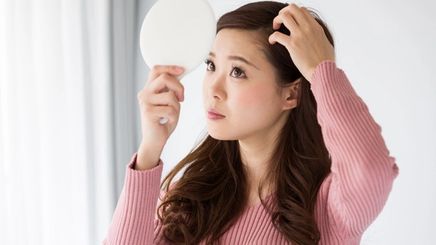
Did you know that a is more common than acne? According to the Journal of Clinical Investigative Dermatology, around half the world experiences flakes for various reasons. How do you identify the root cause of your scalp woes? We break down the different triggers and traits to settle your inner scalp psoriasis vs. dandruff debate.
What Causes Dandruff?
People think that dandruff is a sign of poor hygiene, which isn’t true. You can still have dandruff even if you wash your hair more than three times a week. Apart from having an , various factors can increase your risk of flakes. These include hair product build-up, hormones, and stress.
However, the biggest culprits are – Malassezia and Staphylococcus capitis, in particular. They love hanging out in sebaceous glands, which are most abundant in the scalp, but the catch is they’re part of the normal flora of human skin. You can’t get rid of them completely, which explains why your scalp becomes flaky again as soon as you stop using an .
What Causes Scalp Psoriasis?
Psoriasis is a chronic autoimmune disease marked by scaly patches of skin all over the body, including the scalp. It occurs when an overactive immune system attacks healthy cells, mistaking them for invaders. As a result, the body speeds up skin cell production to quickly eliminate inflammation, causing a buildup of dead skin on the surface.
Your genes and lifestyle choices can trigger and worsen your scalp psoriasis. According to the , stress, smoking, and excessive potentially exacerbate flare-ups. Consider making a few diet or lifestyle adjustments if your condition doesn’t improve despite a good haircare regimen. If your psoriasis flare-ups persist, consult with your dermatologist or prescribing physician on possible treatments.
Psoriasis vs. Dandruff: How to Tell Them Apart
Flakes happen, but is it from superfluous fungi or an immune system issue? At first glance, scalp psoriasis and dandruff look almost identical. But once you know what to look for, it’s easier to differentiate between these two skin conditions.
1. Pay attention to your scalp’s appearance.
Use a handheld mirror to look at what’s happening on your scalp. One of the most prominent features of scalp psoriasis is the well-defined outline of the skin plaque. It also spreads beyond the hairline, so you might see red spots on the scalp, forehead, and neck. Lesions can also appear purplish due to higher melanin content in people with .
Meanwhile, if you’re dealing with dandruff, you might also see redness, but it won’t be too severe. Unlike psoriasis, dandruff patches don’t have a clear pattern, and picking at the flakes will reveal reddish, raw skin.
2. Feel the texture of the flakes.
The size, shape, and color of your flakes can settle the psoriasis vs. dandruff conundrum. In the case of psoriasis, the scalp cannot shed the old skin cells fast enough, so dead skin piles on the surface. This buildup can look like large, silver scales of skin. Flakes are dry, thick, and almost opaque.
On the other hand, the accumulation of oil from the Malassezia yeast results in wet, yellowish flakes that break apart easily. Meanwhile, a dry scalp can produce flakes that are fine and as small as table salt.
3. Find similar plaques on your body.
Since a psoriasis flare-up is related to your immune response, the scaly skin patches may show up on other parts of the body. They’re common in areas exposed to friction, like the elbows, , and .
Another unique fact about psoriasis is that it often develops in symmetrical patterns. For example, when it affects the scalp, the scales on the left side of your head mirror the ones on the right. Dandruff doesn’t have this trait and instead appears in random clusters.
Treating Dandruff at Home
Differentiating scalp psoriasis vs. dandruff brings you closer to the proper treatment. While over-the-counter products can treat dandruff, they’re not suitable for addressing scalp psoriasis. Consult your dermatologist, who can help you treat and manage your symptoms.
You can also revive scalp health by using products with ceramides that repair and nourishe, like Dove Ceramide Intense Repair Shampoo and Dove Ceramide Intense Repair Conditioner.
Differentiating scalp psoriasis vs. dandruff is a challenge, even for professionals. Consult with a doctor to get an accurate diagnosis. In the meantime, focus on your well-being and maintain a healthy scalp and haircare routine. Last but not least, keep your hands away from your head and resist the urge to scratch the itch!